How Does Digital Marketing Work Step by Step
How does a digital marketing strategy begin?
A digital marketing strategy begins with defining clear objectives and identifying target audiences. This involves conducting market research to understand customer needs and preferences. Once the foundation is set, businesses can select appropriate channels and tactics to effectively engage their audience, ensuring a cohesive marketing approach moving forward.
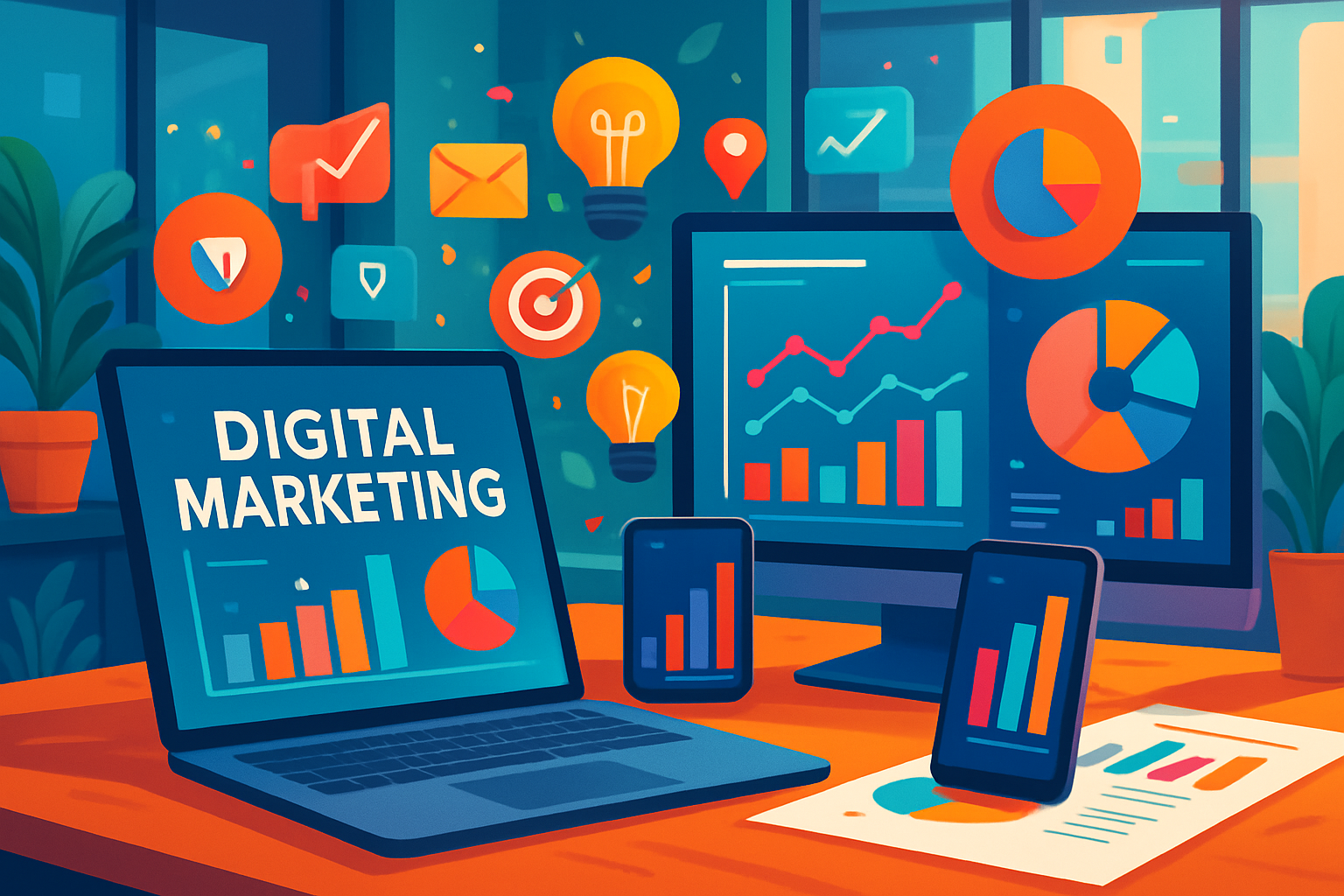
Key Highlights
Step-by-step explanation to establish a robust digital marketing strategy for achieving marketing goals.
Overview of essential digital marketing channels like SEO, social media marketing, and email marketing, to target specific audiences effectively.
Insights into the powerful benefits of digital marketing, including wider reach, real-time analytics, and measurable ROI.
Exploration of essential digital marketing tools and resources to enhance your digital marketing campaigns.
Discussion on the advantages of digital marketing over traditional methods for online presence and audience engagement effectiveness.
Tips for tracking success and fine-tuning marketing efforts using key performance indicators and analytics tools.
Let’s now dive into understanding digital marketing and its step-by-step framework.
Introduction
Are you thinking about how companies do well online and bring in new potential customers? The answer is digital marketing. This way of marketing uses online tools, social media, and websites to reach marketing goals, like building brand awareness and growing sales. Unlike traditional marketing, digital marketing lets companies reach people all around the world with real, trackable plans. In this guide, you will see how online marketing works and how you can use it to meet your business goals.
Let’s take a closer look at what digital marketing includes and the many parts that make it work.
Understanding Digital Marketing
 Navigating the digital world can be fun, but it may also have some challenges. In digital marketing, a business needs to make a good marketing strategy. The goal is to reach new potential customers on the web. When companies keep up with the changes in the digital world, they can grow their digital presence and hit their marketing goals.
Navigating the digital world can be fun, but it may also have some challenges. In digital marketing, a business needs to make a good marketing strategy. The goal is to reach new potential customers on the web. When companies keep up with the changes in the digital world, they can grow their digital presence and hit their marketing goals.
Digital marketing is more than just making ads. It uses analytics, audience targeting, and interactive content. These things help businesses run good campaigns that get results. To stand out from others, planning and action both matter in digital marketing.
What is Digital Marketing?
Digital marketing is about using the internet and devices to promote products or services. It covers things like email marketing, posting on social media, and search engine optimization. These ways help brands get seen more online. For example, a business can work on its website to get more organic traffic. They can also pay for ads that help people take action on their site.
One big plus of digital marketing is that it can do many things. Brands can find the right target audience with tools like Google Analytics and see how people interact with what they share. It does not matter if you are a small startup or a well-known company. Digital marketing gives you a flexible way to get good results.
With digital marketing, you can make your online presence stronger. You reach your audience on the social media platforms and search engines that they use most. You can drive more website traffic and connect with your customers in real ways. If you use digital marketing in the right way, there are so many good things you can get from it, like trust and loyalty from the people who matter most.
Key Components of Digital Marketing
Digital marketing uses many channels to reach people. Main digital marketing channels are content marketing, search engine optimization, and social media marketing. Each is important for reaching different marketing goals.
Content marketing uses blog posts and videos to share useful information. This helps brands connect with their audience and build trust. Search engine optimization makes it easier for people to find a business when they search online.
Also, social media platforms such as Facebook and Instagram let brands talk to their followers directly. When you put all of these together, your digital marketing is stronger. This brings better reach and a good user experience, which helps people connect with your brand.
How Digital Marketing Has Evolved in the United States
The United States now focuses more on the digital landscape instead of old ways of advertising. In the early 2000s, most businesses used email and simple sites. Now, AI-powered tools and marketing automation help them handle more complex plans. This lets them reach their marketing goals better.
Mobile devices are everywhere now. Almost everyone has a smartphone. Because of this, brands can talk to people anytime, anywhere. People get personalized campaigns made just for them because of these mobile devices.
Case studies and real numbers show that digital marketing lets US brands match with global leaders. This change shows how much innovation matters to meet new marketing goals.
Now, let’s look at why digital marketing is so important today.
The Importance of Digital Marketing Today
 In today’s world, digital marketing is a must for anyone who wants their business to do well online. It helps companies reach their target audience using the right digital channels, making a direct link between people and the business.
In today’s world, digital marketing is a must for anyone who wants their business to do well online. It helps companies reach their target audience using the right digital channels, making a direct link between people and the business.
There are many benefits of digital marketing. It can help get more website traffic, raise conversion rates, and let you build campaigns to fit what your customers want. Unlike older ways of reaching people, digital platforms give you the chance to change and improve your work as you go, because you get clear feedback right away. This lets companies adjust their plans in real time.
Now, let’s look at what is making this change so important.
The Shift from Traditional to Digital Channels
Today, business moves fast. The old traditional marketing ways, like print ads and radio, are not enough now. People see more power in new digital channels. These include things like social platforms, email marketing, and SEO-focused websites. These tools help you connect with more people and make your message heard.
One big benefit of digital channels is their ability to reach the right audience. You can create content that speaks to the people who matter most. You can use detailed grouping based on what people like and do. This is something billboards or flyers could not do as well.
Having an online presence gives you big chances to talk to potential customers. Any business, from a local bakery to a large tech company, can use email marketing or run google ads to speak to their buyers online. The digital world lets you reach more people and also grow faster.
You can also see how your marketing efforts are working in real time. This means you can make changes right away if needed. This ability to change and measure is important and helps you win in today’s tough market.
See why it is so important to choose digital marketing when you want your business to grow and get results.
Why Businesses Need Digital Marketing
Every business, big or small, needs digital marketing to be important in today’s world. With digital marketing, you get to talk to your specific audiences, set up tasks to run on their own, and reach your marketing goals faster.
You also get another big benefit. You can reach people all over the globe with no borders to stop you. When you use effective digital marketing like SEO, your brand, products, and services get seen by more people.
When you connect with your target audience on platforms they already use, you help people trust your brand. These moments where you talk with them also help create a community feeling. Because of this, your business can get loyal customers and do well for a long time.
Keep reading to see how digital marketing changes how people make choices.
Impact of Digital Marketing on Consumer Behavior
Digital marketing plays a big role in the way people make choices these days. With more brand awareness, businesses can get into the minds of people who shop online.
For example, when people see ads that are meant just for them, they often want to check out what that business is selling. In the same way, emails that call your name and know what you want help you trust the brand and stick with it. This makes people buy more and look for new things from the same place.
If you want to shape consumer behavior, you need to give people things that let them take part, like online polls, live question times, or getting help through WhatsApp. This kind of service creates a better bond between you and your customer. It also helps turn someone just looking around into someone who comes back and uses your product or service many times.
Now let’s go over how digital marketing brings many good things for people who are new to it.
Benefits of Digital Marketing for Beginners
 When you start to work with digital marketing, you get the chance to explore many new paths. This is great for beginners who want to get started online. This way of working is less costly and gives you the freedom to try out different ideas. You can pick how to spend your money and test new ways to reach people.
When you start to work with digital marketing, you get the chance to explore many new paths. This is great for beginners who want to get started online. This way of working is less costly and gives you the freedom to try out different ideas. You can pick how to spend your money and test new ways to reach people.
With digital marketing, it is easy to reach the group you want to talk to on digital channels. This helps make your marketing campaigns work better. You can see your results right away, so you can check if what you are doing is working. Seeing these numbers tells you who is interested, what they like, and how many turn into real customers, so you can have better conversion rates.
Having this information makes it possible for you to make changes quickly and easily. You can be sure that your marketing goals fit the people you reach. All this helps your business grow and do well over time.
Cost-Effectiveness and Flexibility
Digital marketing gives businesses a way to reach people without spending as much as with traditional marketing. This helps companies use their money better and not waste as many resources. There are many digital channels that a business can use. With these, companies can make their marketing efforts fit the needs of specific audiences. This makes each campaign work better.
Flexibility is important in the digital landscape. Businesses can change what they do at any time by looking at performance data and watching market dynamics. When brands use marketing automation tools, they can quickly change their approach. This helps them stay up to date and respond fast to what is happening now. In the end, digital marketing helps brands get more from their budget and reach their marketing goals.
Ability to Reach Targeted Audiences
Using digital marketing helps businesses reach the right people. This lets them plan their marketing efforts better. With targeted ads on different digital channels, they can send messages to specific audiences. They choose these groups by looking at things like age, what people like, and how they act.
This makes marketing campaigns work better and saves time. It also helps companies talk to potential customers in a way that matters to them. The content is personal and fits each group. Because of this, people have better experiences with a brand. This often means more people take action, like making a purchase, and brands build stronger loyalty over time. Higher conversion rates and loyal customers come from smart use of digital marketing.
Real-Time Data and Measurable Results
Real-time data is now changing the game in digital marketing. It helps businesses make quick and smart choices. When you use analytics tools, you can see how your marketing campaigns are working right away. This means you can make fast changes to your strategy when you notice something important. Getting information fast helps give people a better user experience. It also helps raise conversion rates since your content can reach the right people in the best way. You get clear numbers, such as click-through rates and how much people interact with your content, to see how well your marketing efforts do. By looking at this data, you get to adjust your digital marketing campaigns. This makes your team work towards your main marketing goals and helps make your overall strategy better.
Personalization and Customer Engagement
Making content and experiences fit each person’s likes helps brands connect better with people. This makes customer engagement stronger because people get valuable content that fits what they care about. By using data on what customers do, businesses can make digital marketing choices that are just right for their audience. This can help bring in higher conversion rates and give a better user experience.
With marketing automation tools, brands can talk to potential customers easily on different digital channels. This keeps the interaction steady and makes the process smoother. Since personalization is now a key part of effective digital marketing, brands that make customer engagement a priority will earn loyalty and support from their audience. This can help them reach their marketing goals.
Types of Digital Marketing Channels
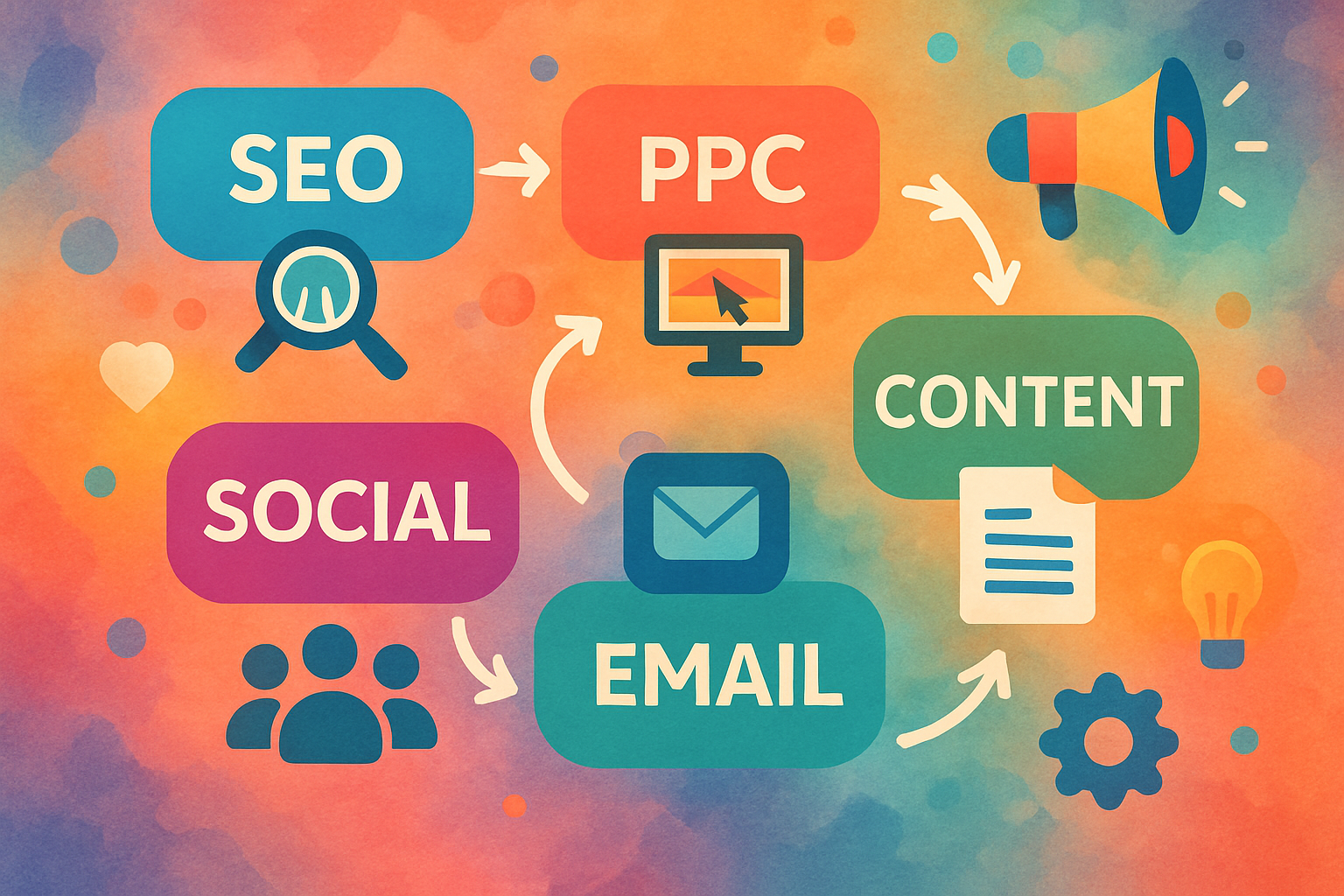 There are many digital marketing channels that people use, and each one has its own role in a good marketing strategy. Search engine optimization (SEO) helps your website show up better on search engines. This can boost organic traffic and help raise your conversion rates. Pay-per-click advertising (PPC) gives quick results by showing targeted ads on search engines and social media platforms. Content marketing is all about making valuable content that can get the interest of potential customers. Email marketing lets you reach out to people in a direct way.
There are many digital marketing channels that people use, and each one has its own role in a good marketing strategy. Search engine optimization (SEO) helps your website show up better on search engines. This can boost organic traffic and help raise your conversion rates. Pay-per-click advertising (PPC) gives quick results by showing targeted ads on search engines and social media platforms. Content marketing is all about making valuable content that can get the interest of potential customers. Email marketing lets you reach out to people in a direct way.
Also, using social media platforms helps that brand awareness and gets you talking with specific audiences. At the same time, influencer marketing lets you use the trust of well-known figures to reach more people. This makes influencer marketing a strong tool in the digital marketing world now. All of these digital marketing channels work together to build a strong digital landscape for your business or brand.
Search Engine Optimization (SEO)
A strong digital marketing strategy always has search engine optimization as an important part. SEO helps your website show up better on search engines. This brings more organic traffic and can help raise your conversion rates. When you do keyword research and work on your on-page elements, your business can match the content marketing strategy to what people are looking for. This makes it easier to reach potential customers.
SEO does more than get your brand noticed. It helps you build a strong online presence, too. When you follow good SEO practices during your digital marketing campaigns, your marketing efforts bring real results that you can see and measure. So, SEO is a must-have to make your digital marketing and marketing campaigns work well.
Pay-Per-Click Advertising (PPC)
Pay-per-click (PPC) advertising is a digital marketing strategy that helps businesses get the right people to visit their website. With this marketing strategy, you pay only when someone clicks your ad on search engines or social media. This helps you keep control over your budget and get more from your marketing efforts. You can use PPC to improve your brand’s visibility and also raise your conversion rates, since people respond quickly to these ads. PPC lets you show your ads to specific audiences by using their age, location, or how they act online. This makes PPC an important part of any digital marketing plan.
Analytics are helpful too. They let you look at the results, so you can keep working to make each campaign better and help you reach your marketing goals.
Social Media Marketing
Social media marketing is a good digital marketing strategy for helping brands reach their target audiences. It is a great way to connect with potential customers in a more open and lively space. With social media, brands can share valuable content and have real talks with people. Using different social media platforms, businesses can make marketing campaigns just for the specific audiences they want to reach. This is good for building brand awareness and making sure customers keep coming back.
It is key to make social media posts that people will want to talk about and share. This helps brands watch how well their posts do and know when they need to change their marketing strategy. By using marketing automation tools, a business can save time and get their work done faster. The tools help reach out to people all over the digital landscape, build honest connections, and help brands get the most out of their marketing automation and digital marketing work.
Content Marketing
An effective digital marketing strategy starts with making a content marketing strategy that puts valuable content first. When you focus on what your potential customers need and like, your brand can make the user experience better. This also helps you build trust with them. Using different digital channels like social media and email marketing will help you share content with more people, so you can reach the right audience.
Telling your brand story in these channels can make people engage more with what you share. When your messaging is always the same, it helps grow brand awareness. To see if your campaigns work, you should track key performance indicators. This way, you can know what’s working well or not. Then you are able to make changes fast and keep up in the fast-moving digital landscape.
Email Marketing
Email marketing is a strong part of any digital marketing strategy. It helps businesses speak directly with their audience. When companies give people valuable content and personal messages, they can keep leads interested and get better customer engagement.
Sending emails to specific audiences is important. Marketers can organize groups that fit, so each message feels right for them. This line-up helps a business reach its marketing goals.
With automation, email marketing is even easier. It lets businesses run campaigns smoothly on digital platforms and watch important key performance indicators. This way, they can adjust and improve what they do.
If a business includes email marketing in a robust digital marketing strategy, it will likely see higher conversion rates and better customer loyalty.
Affiliate and Influencer Marketing
Affiliate and influencer marketing are strong parts of a digital marketing strategy. Working with influencers helps brands reach new people. It can help raise brand awareness and boost conversion rates. When brands work with influencers, they often get valuable content that followers like. This kind of content feels true and can make people want to try a product or service.
Looking at key performance indicators is also important. It lets people see what works well. This helps them make sure that every affiliate link or influencer collaboration fits with their marketing goals. It also makes the user experience better across different digital platforms. All of this is key to having a robust digital marketing strategy.
Digital Marketing vs. Traditional Marketing
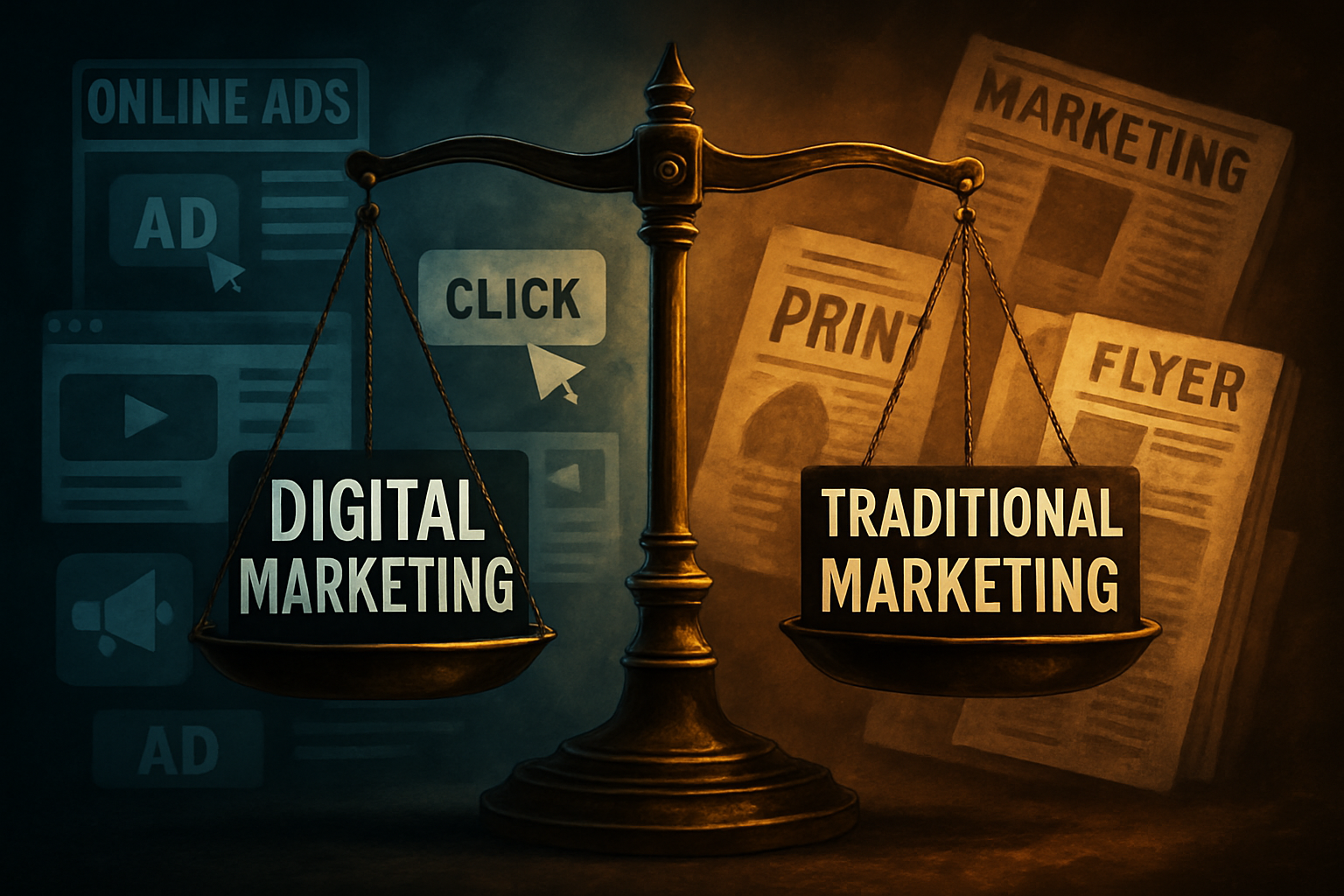
The main difference between digital marketing and traditional marketing is how far they reach and how they get people involved. Digital marketing uses online platforms to target the right people. It can change to fit real-time data and what people do online. This way is fast and flexible. It works very differently from traditional marketing, which uses set costs and goes to a wider group at once. In digital marketing, success is measured using key performance indicators. This gives instant feedback, so you can quickly decide what to do next. As the digital landscape changes, it becomes more important for all brands to use a strong digital marketing strategy. If you want to reach more people and have good conversion rates, the right marketing strategy matters now more than ever.
Differences in Reach and Cost
The differences you see between digital and traditional marketing are big when you look at who you can reach and how much you spend. With digital platforms, it is easy for a business to get to a much larger and global group of people. You can also connect with specific audiences by choosing who will see your ads. On the other hand, traditional marketing often lets you reach only local people. It also costs much more.
With digital marketing, there are ways to spend less, like using pay-per-click ads. Marketers can use money better and keep track of how much they get back from what they spend. This way gives you more choice. You can adjust your marketing strategy as you see new market dynamics. You do not have to spend more than needed to reach your goal. In the end, an effective digital marketing strategy lets you reach more people and spend less than what you would with traditional marketing. This helps you make your marketing efforts stronger and better fit for your needs now.
Measuring Success in Both Approaches
Understanding how to measure success in digital marketing and traditional marketing is important. Digital marketing is strong because it gives clear numbers to follow, like website traffic, conversion rates, and how much people are talking with you on social media. These numbers help you see in real time how well a campaign is working. But traditional marketing is different. It uses things like brand awareness and how many people see or hear the message. People usually find out these things through surveys or looking at sales figures.
When you bring together digital marketing and traditional marketing, you get a marketing plan that takes the good points from both sides. This way, you can hit your marketing goals, connect with more people, and improve your plan as you go. Focusing on what you can measure helps you keep making your marketing strategies better over time.
Which Is Better for Your Business?
When you want to pick a marketing plan for your business, you need to think about a few things. Look at your budget, the target audience, and the goals you want to reach. Digital marketing can often be a good choice if you have a small budget, as it can give you results that you can see and measure. But traditional ways can help you reach more people if that is what you want. Think about these things, and they will help you make the best choice for you.
Buyer’s Journey in Digital Marketing
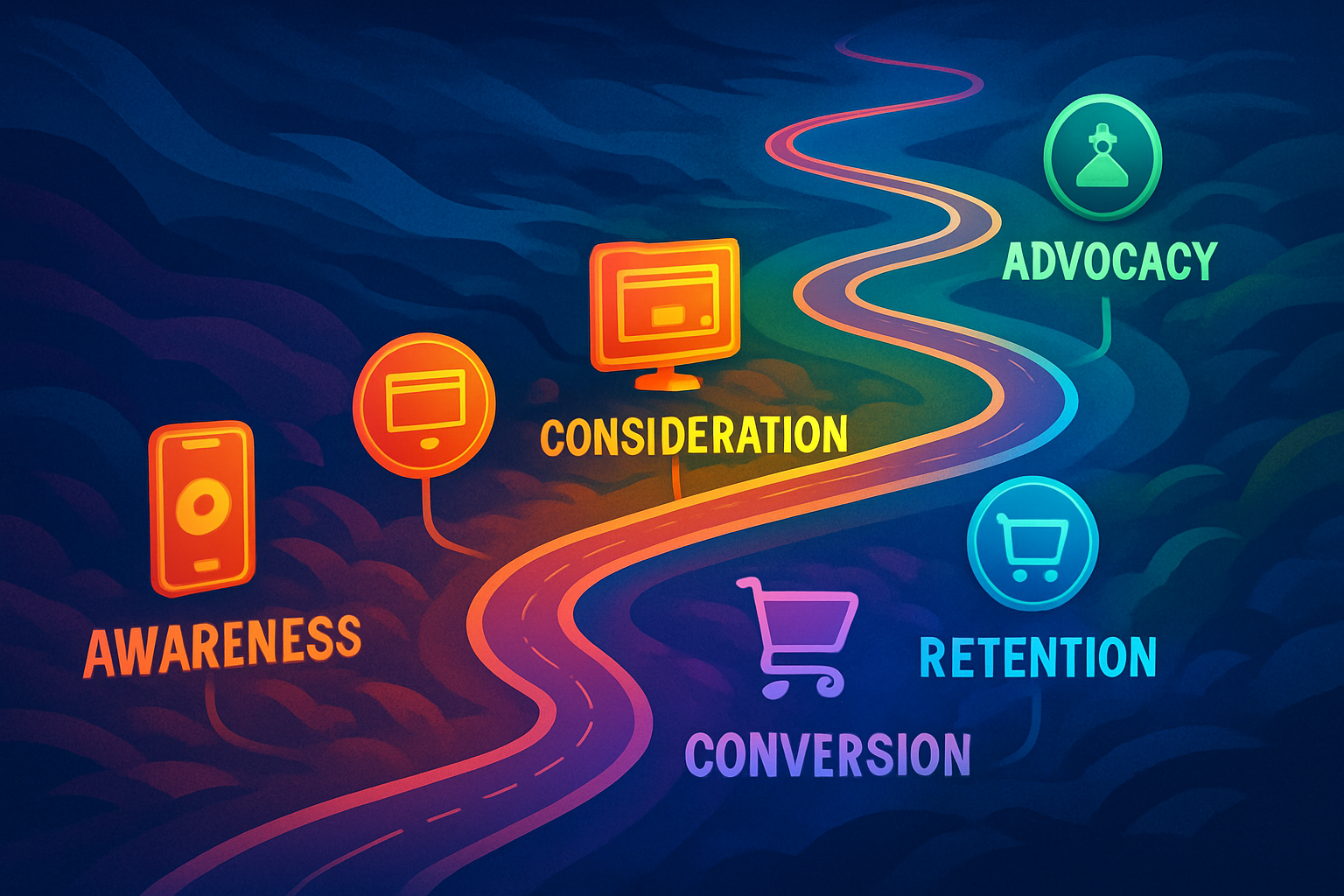 To do well in digital marketing, you need to understand the buyer’s journey. This journey has three main parts: awareness, consideration, and decision. In the awareness stage, possible customers figure out what the problem or need is. Next, during the consideration stage, they look for answers and compare the options. In the last stage, they decide on the right product or service for them.
To do well in digital marketing, you need to understand the buyer’s journey. This journey has three main parts: awareness, consideration, and decision. In the awareness stage, possible customers figure out what the problem or need is. Next, during the consideration stage, they look for answers and compare the options. In the last stage, they decide on the right product or service for them.
It is important to use good content and strong marketing efforts at each part of this process. This helps build trust, gives users a better experience, and helps push up your conversion rates. So, be sure to guide potential customers clearly from the start to the end of their buyer’s journey.
Awareness Stage
Recognizing the awareness stage is key when you set up a digital marketing strategy. At this first step, a potential customer meets your brand for the first time. It is here that you show what you have to offer and what makes you different. This early stage is about building brand awareness and getting people interested in what you have.
To do this, use targeted content marketing and share interesting social media posts. These methods help your digital marketing efforts by getting your brand in front of the right people. Social media makes it easy to grab attention and start a connection with those who might later become customers.
Using search engine optimization is also very important, as it brings you up in search engines when people look for things they need. When you create valuable content for specific audiences, you help more people see what you do. This lays a strong base for the buyer’s journey and gets people ready for the next steps as they move closer to making a choice.
Consideration Stage
During the consideration stage, potential customers look at different choices to find what they need. This is the time when an effective digital marketing strategy uses helpful content to guide them. You should show off product benefits and try to solve their problems. For this, use things like product comparisons, video demos, and blog posts that talk about the most important features. If you use marketing automation tools, your messages can be personal and fit each user better. Good and valuable content is key in this stage. It helps people to trust your brand and take the next step on the buyer’s journey. With the right marketing strategy, you help them move closer to choosing you.
Decision Stage
At the decision stage, potential customers look at their choices. They want to pick the one that fits their needs and what they like best. It is good to share valuable content that talks about their own problems. This helps them make up their mind.
When you use digital marketing in the right way—like retargeting ads and emails made just for them—your brand will stay fresh in their mind. Sharing things like testimonials, case studies, and reviews from real users can help people trust you more. This makes it easier for them to go with your product or service.
Having a strong digital presence at this step is important. It helps you get better conversion rates and also keeps people coming back to your brand later.
Post-Purchase Loyalty and Advocacy
Building post-purchase loyalty is all about making the user experience easy and smooth. When you reach out to people using personalized email marketing, they feel special and confident about what they bought. This often makes them want to buy again. If you get feedback from your customers and use marketing automation tools to send them offers that fit them, you build a stronger relationship with them. This helps happy customers tell others about you and supports your digital marketing strategy.
When you give loyal customers special deals, you raise your brand awareness. They are more likely to share what they love about you, which helps your digital marketing stand out. This kind of support helps your conversion rates improve, because people trust real stories. Overall, this makes your marketing efforts stronger as you try to do well in the busy digital landscape.
Essential Tools and Resources for Beginners
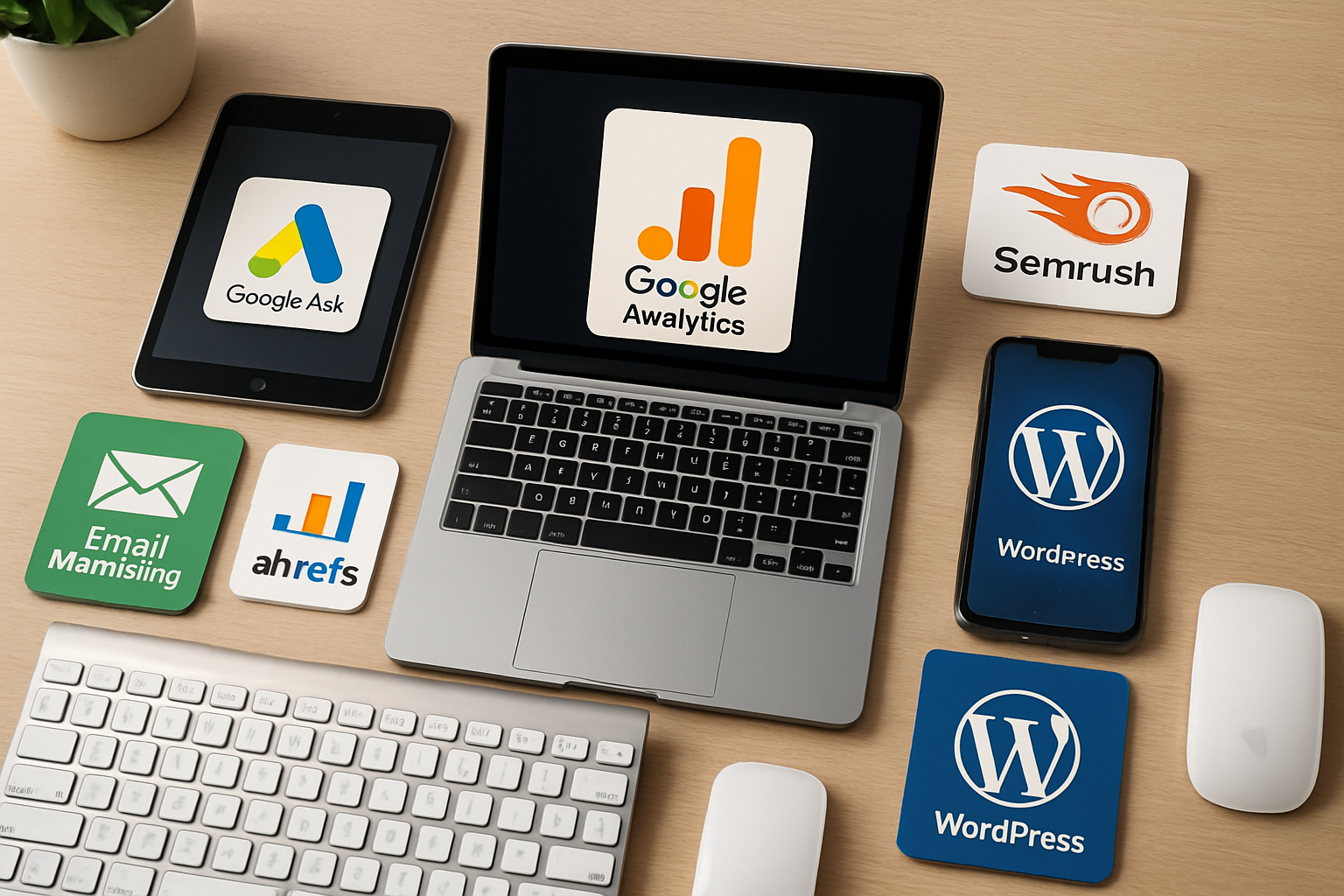 To get started with a good digital marketing strategy, you need the right digital marketing tools. This can help your marketing strategy and save you time. If you are new to digital marketing, start with marketing automation tools that make your work easy. You should also use analytics platforms like Google Analytics to keep track of how people use your site. Try to focus on making valuable content. Tools and resources for content marketing will help you reach your target audience better.
To get started with a good digital marketing strategy, you need the right digital marketing tools. This can help your marketing strategy and save you time. If you are new to digital marketing, start with marketing automation tools that make your work easy. You should also use analytics platforms like Google Analytics to keep track of how people use your site. Try to focus on making valuable content. Tools and resources for content marketing will help you reach your target audience better.
You can also use online learning platforms or take certifications. This will give you basic knowledge and help you get the most out of your marketing strategy. When you build a digital marketing toolkit that matches your business goals, you will be able to get more done. This helps your campaigns work well in the digital landscape and supports you as you grow.
Basic Equipment and Software Needed
A good computer or laptop is at the heart of your digital marketing work. It helps you run the many tools and platforms you need each day. Some key tools to have are graphic design apps like Canva that help you make sharp visuals. For keyword research, it is helpful to use SEO apps like SEMrush or Ahrefs.
You can get more out of your digital marketing when you use strong communication tools like Slack. Project management apps like Trello let your team work better together. Use Google Analytics to keep track of your website traffic and see what works in your digital marketing efforts.
Investing in these will help with your marketing efforts and build a good base for your overall strategy. These tools make it easier to reach your goals and stay on top of what’s new in digital marketing.
Free and Paid Digital Marketing Tools
Using both free and paid digital marketing tools can help you get better results from your marketing efforts. Free tools like Google Analytics and social media managers give you useful information about how people act on your digital channels. You do not have to pay to use these. But paid digital marketing tools like SEMrush and Hootsuite offer more, so you can take a closer look at your marketing campaigns and even automate some work.
If you add both free and paid tools to your digital marketing strategy, your business can grow its online presence. This will help you watch your key performance indicators in a better way. Over time, this will bring more organic traffic to your website and other digital channels. Using the right digital marketing tools, both free and paid, is a smart move in creating a good marketing strategy on social media and beyond.
Online Learning Resources and Certifications
There are many ways to learn about digital marketing online. You can find courses and certificates on websites like Coursera, Udemy, and HubSpot. These sites offer clear lessons on important things like SEO, content marketing, and social media. Many of these courses give you certificates. This is good for your resume and shows you want to get better with digital marketing skills. You can also watch webinars for your industry and read case studies to learn even more. Choosing from these different ways to learn helps all people, no matter how they study best. This is a great way to build a strong marketing strategy or a robust digital marketing strategy.
Building Your First Digital Marketing Toolkit
Having the right tools is important if you want to run effective digital marketing campaigns. You need things like keyword research tools to help with search engine optimization. Social media scheduling platforms can help you plan and post content at the right time. Be sure to use email marketing tools, so you can send messages to your audience without doing it all by hand. This will keep people interested and help you get more sales or sign-ups.
It is also good to use analytics tools like Google Analytics. These tools let you see your website traffic, learn about your users, and find out what is working. This helps you improve your marketing strategy when you see what people like on your site and social media channels.
With this group of tools, you will be ready to create a strong digital presence and run great marketing campaigns. These tools will help your marketing efforts grow over time.
How to Get Started with Digital Marketing (Beginner’s Guide)
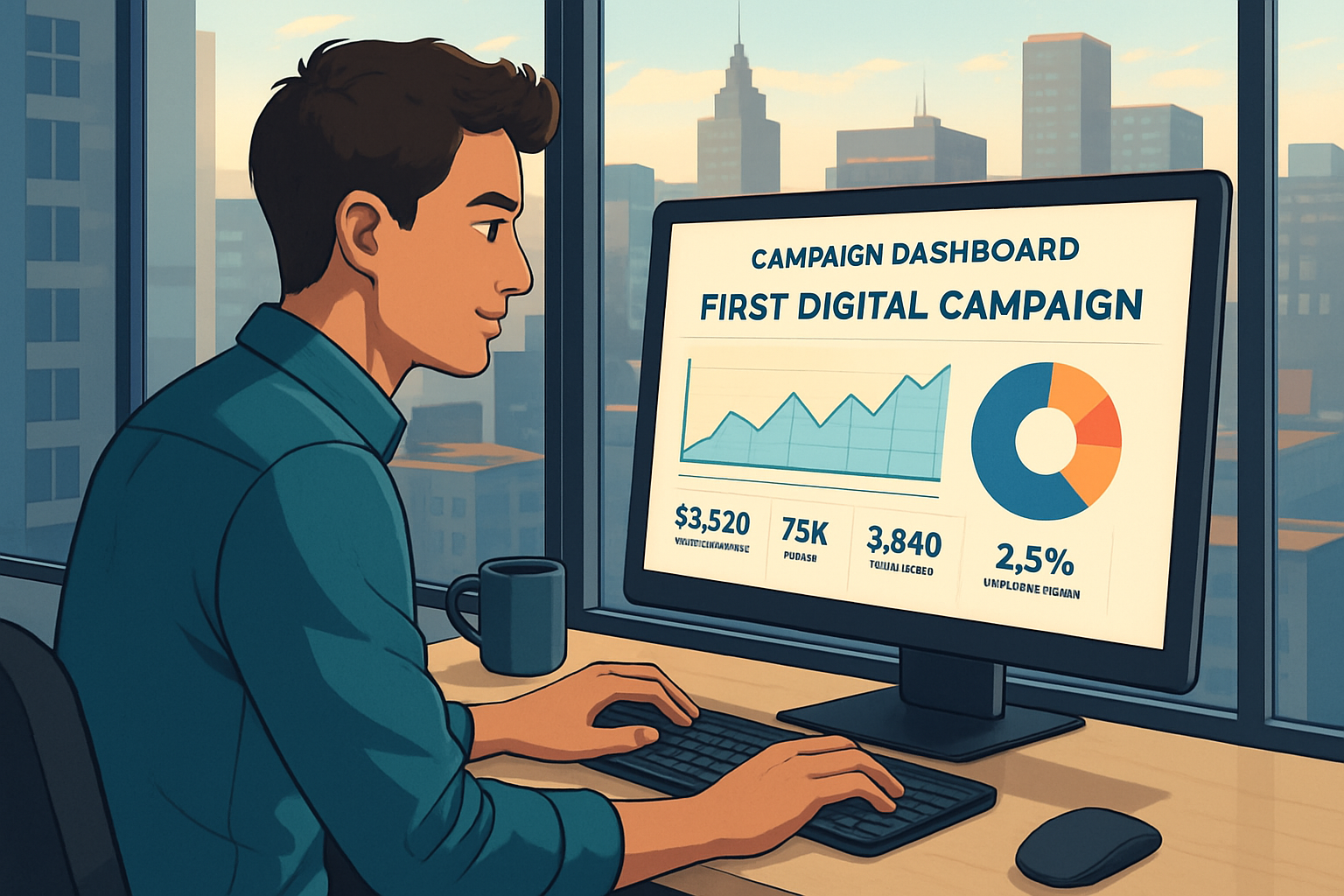
Starting out in digital marketing takes some planning. You need to be clear about your marketing goals from the start. Once you know these, you can build your digital marketing strategy around them.
It’s important to learn about your target audience. Find out what they like and how they behave online. This helps you make content that speaks to them.
Having a strong online presence across digital channels matters the most. You should keep an eye on your campaigns with different tools. Change what you do as needed, so you stay focused on your business goals and can keep up with the fast-changing digital landscape.
Setting Realistic Expectations
Setting realistic goals is very important in any digital marketing strategy. You need to know that you will not see results right away. It takes time and effort to build brand awareness and bring more people to your website. Having a well-made marketing plan with clear milestones helps you watch your progress by using key performance indicators. Using analytics tools gives you a way to check if your marketing campaigns are working well. This lets you make better choices and change things when needed. Always think about your target audience and how they act. Make sure your hopes match market dynamics. This will help your online presence grow and do well with other companies.
Common Mistakes to Avoid
If you do not pay enough attention to having a clear digital marketing strategy, your marketing can miss the mark right from the start. When you don’t learn about your target audience first, your marketing tactics might not connect with the people you want to reach. This can waste your time and money. If you do not check and use your data, you miss chances to make your marketing better. When your message is not the same across different digital platforms, people can get confused and may not remember your brand. This can hurt your brand awareness with potential customers. If you overlook the value of good content marketing, it can be hard to get people interested in what you offer or reach your marketing goals. To get successful digital marketing results, be careful not to fall into these mistakes.
Skills You Need to Succeed
Moving through the digital landscape means you need to have many different skills. You must be able to reach your target audience and hit your marketing goals. First, you should know SEO techniques to help get more organic traffic to your website. Second, be good at content marketing. That helps you make valuable content that will speak to potential customers. You also need to use social media platforms for social media marketing. This is a good way to make people aware of your brand.
Being able to look at data is also key for anyone in digital marketing. You have to look at key performance indicators to learn what is working and what is not. This helps you change your marketing strategy or digital marketing strategy to get better results. Using marketing automation tools will let you set up and run campaigns more easily. This can help your marketing team save time and do even better in the future. All these things work together so your overall digital marketing can grow and reach more people online.
Building a Digital Presence from Scratch
Building a digital presence starts with a clear plan for your digital marketing strategy. Pick the right digital channels to reach your potential customers. These channels can be social media platforms and a website that is easy to use. To connect with your target audience, share valuable content often. Make sure to post and update this content on a regular basis. Use email marketing and search engine optimization to help more people see your business. Bring all these parts together in your marketing plan. This will help you get better brand awareness and a stronger online presence. When you follow these steps, you can meet more people and build lasting connections with them.
Step-by-Step Guide to Digital Marketing Success
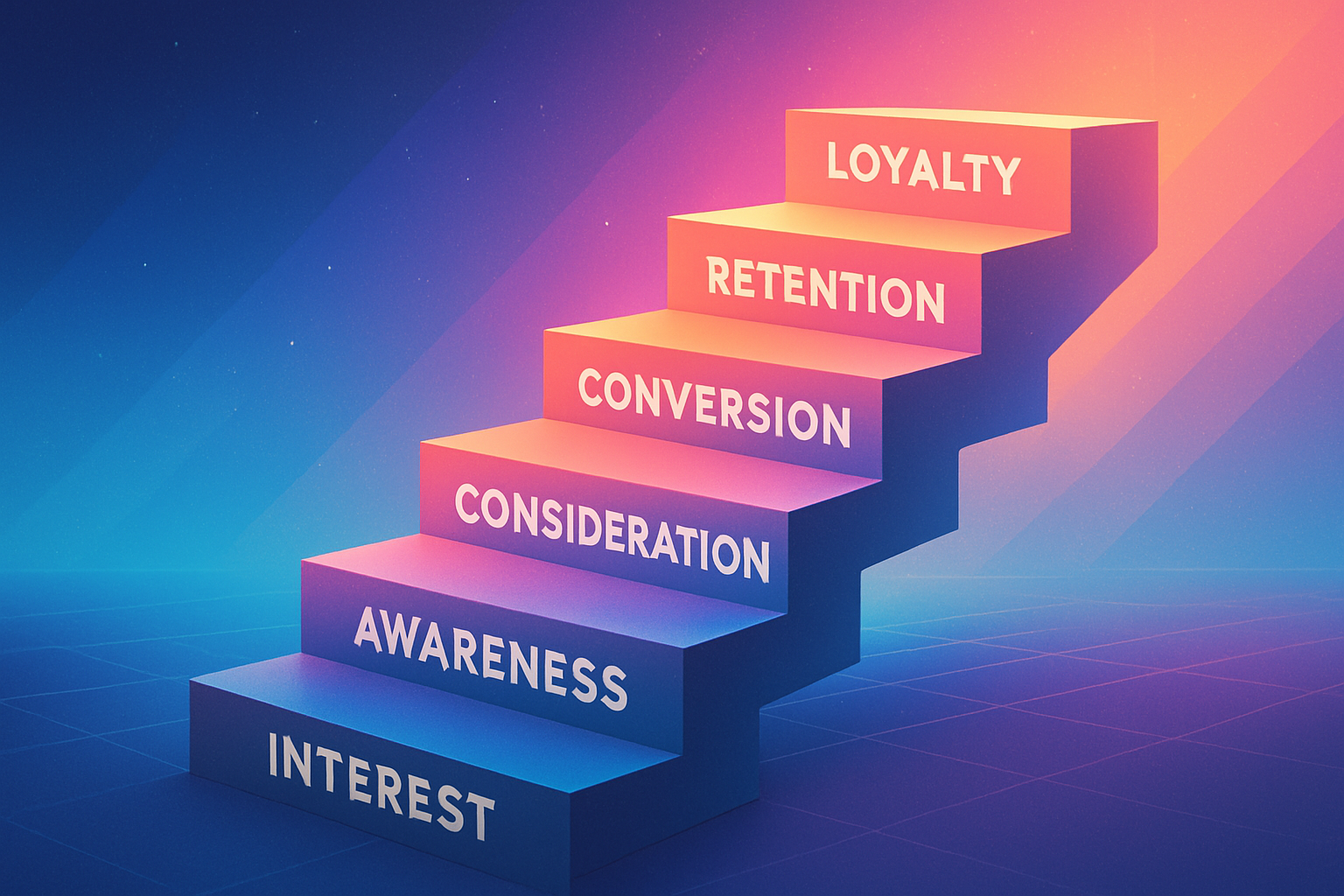 A structured way to find success in digital marketing is important. You should start by setting your digital marketing goals. This helps guide everything you do so you can get the outcome you want. The next step is to know and study your target audience. Doing this lets you connect with the people you want to reach.
A structured way to find success in digital marketing is important. You should start by setting your digital marketing goals. This helps guide everything you do so you can get the outcome you want. The next step is to know and study your target audience. Doing this lets you connect with the people you want to reach.
It is also good to look at what your competitors are doing. This helps you spot new chances for your brand. Picking the right digital marketing channels will get your message in front of more people. Having a strong content strategy is key to keeping your target audience interested. Make sure to plan your budget well so you use your resources wisely.
When you run your digital marketing campaigns, keep an eye on how they perform. This will help you to change your strategy as needed, and get better results over time.
Step 1: Define Your Goals and Objectives
Success in digital marketing starts when you have clear goals and plans. Taking this first step helps build your digital marketing strategy. It makes sure your work towards marketing matches your business goals. When you write down your marketing objectives, it will guide your campaigns. You will also be able to measure how your marketing is doing. This gives you insights you can use to make things better.
If you use the SMART way to set your marketing goals, it will add more clarity to your digital marketing strategy. That means your goals should be specific, measurable, achievable, relevant, and done in a set time. These steps let you check and update your marketing efforts often. This helps improve your overall strategy and can help you reach your target audience in a better way.
Step 2: Identify and Research Your Target Audience
Understanding your target audience is key to building a good digital marketing strategy. When you learn about the age, likes, and online habits of your customers, you can make marketing campaigns that fit them. Use tools like social media, surveys, and Google Analytics to get the info you need. Finding out about specific audiences can make the user experience better. It can also help more people connect with your content.
When you really know who you talk to, your content strategy can work well. This helps you meet your marketing goals and can lead to better conversion rates. A clear picture of your target audience helps you run a successful digital marketing strategy. With strong marketing campaigns and the right use of social media, you can reach more potential customers and get good results.
Step 3: Analyze Your Competition
Understanding who the main competitors are is key to a strong digital marketing strategy. Start by finding the big names in your field. Look into how they use their marketing channels, like social media, SEO, and different content marketing tactics. This helps you see what they do well, where they could do better, and how you can stand out.
Use tools such as Google Analytics and social media monitoring to collect data. Check things like their engagement, how people interact with them, and their conversion rates. When you study their marketing strategy, you can update your own marketing tactics for better results. This way, you will have a good chance to reach potential customers and do well in the digital marketplace.
Step 4: Choose the Right Digital Marketing Channels
Choosing the right digital marketing channels is important for your overall strategy. Each digital platform, like social media, email, or search engines, works best for different people and marketing goals. You need to know what your target audience likes. This will help you pick channels that boost engagement and improve conversion rates.
Try to use both inbound marketing and paid ads. This way, you can reach more people and get better results. When you test different digital platforms, you can find out which ones are best for your marketing campaigns. This helps your marketing efforts connect with potential customers in the digital landscape. Using these marketing tactics makes your message stronger and reaches more people.
Step 5: Create a Content Strategy
An effective digital marketing strategy needs a strong content strategy that matches your business goals. First, find out what types of valuable content your target audience is looking for. This content can be things like blog posts or social media posts that people find helpful or fun. Using a content calendar will help you keep your posts steady. It also makes it easier to stay on track. To make your content easier to find, use SEO best practices so your content shows up well on search engines.
You should track how people use your content by using analytics tools. Look at user engagement and see how well your conversion rates are doing. Use this data to make changes to your content strategy as you go. This will help your marketing efforts get better and give your audience a good user experience. Over time, this is the way to grow and have a more effective digital marketing strategy.
Step 6: Set a Budget and Allocate Resources
Setting a clear budget is very important for your digital marketing strategy. You need to plan how to use your resources and look at the costs for things like social media ads, SEO work, and making content. This way, you can make sure your marketing funds are not wasted and they help the business reach its goals. Over time, you may need to make some changes if market dynamics change. Check your results often by tracking key performance indicators. This helps you see which marketing strategy works best and gives you the most for your money. By doing this, you can lower waste and get more from your digital presence.
Step 7: Execute Campaigns and Implement Best Practices
Executing campaigns means to put your planned digital marketing strategy into action. Use targeted digital channels for this. As you work, keep a close eye on your results so you can make quick changes to your marketing strategy. Following best practices such as A/B testing and making sure users have a smooth user experience will help boost engagement and conversion rates.
Focus on quality content for your digital marketing plan. Use marketing automation tools to help make things easier. It is also important to check your performance often. This means looking at website traffic and conversion rates to see what is working. Use this information to adjust your work. This update is key for your digital marketing plan, so your campaigns do well in the fast-changing digital landscape.
Step 8: Monitor Performance and Collect Data
Watching performance and getting data is needed for a good digital marketing strategy. You should use the right tools to check key performance indicators like website traffic, conversion rates, and how people use your site. This will help you see which marketing campaigns work for your target audience and which ones need to be better. When you keep an eye on these numbers all the time, you can make quick changes, so your marketing efforts fit your business goals. This does not only make your marketing plan stronger but also lifts up your overall strategy for new digital marketing campaigns.
Step 9: Optimize and Adjust Your Strategies
Keeping track of results is very important, but the next step is to make changes to your digital marketing strategy. Look at key performance indicators (KPIs) to see how well your marketing strategy and efforts are doing. Find parts that need to be better. This could mean changing how you do content marketing or moving your time and money to different digital channels.
A robust digital marketing strategy needs to be flexible. You should often check analytics tools to find out how people act and what is happening in the market. If you keep looking for ways to improve, you will make the user experience better, increase conversion rates, and make sure your digital marketing goals match your business goals and what your customers want.
Overcoming Common Digital Marketing Challenges
 There are many challenges when you work in digital marketing. It is key to keep up with the fast changes and trends. To stay ahead, you need to change your marketing strategy as things in the market shift. If your budget is tight, you will have to make a good marketing plan so that you use your money well. It is also hard to be noticed when there is a lot of competition. This is why you should use strong marketing tactics that speak to your target audience. Using automation tools and good analytics can help a lot, too. They let you use data when making choices for your overall strategy. If you face these problems and find ways to solve them, you set yourself up for successful digital marketing campaigns.
There are many challenges when you work in digital marketing. It is key to keep up with the fast changes and trends. To stay ahead, you need to change your marketing strategy as things in the market shift. If your budget is tight, you will have to make a good marketing plan so that you use your money well. It is also hard to be noticed when there is a lot of competition. This is why you should use strong marketing tactics that speak to your target audience. Using automation tools and good analytics can help a lot, too. They let you use data when making choices for your overall strategy. If you face these problems and find ways to solve them, you set yourself up for successful digital marketing campaigns.
Adapting to Rapidly Changing Trends
Adapting to new trends is very important in the fast-moving world of digital marketing. When you have a flexible digital marketing strategy, your business can change fast when new things come up or people change the way they act online. Talking with your target audience on social media platforms and making user experience better helps your marketing efforts stay useful and strong.
If you watch what happens in the market and use analytics tools, your business can look at data right away. This helps you know when to make changes to your marketing campaigns. If you are open to change, your brand will become stronger and keep its online presence as people’s likes and dislikes move over time.
Managing Budget Constraints
Dealing with a tight budget is important for any strong digital marketing strategy. It is good to put the focus on ways that give the most value from your spend. This keeps your marketing efforts strong even if money is tight. Using cost-effective ways, like social media marketing and email marketing, can help save funds. At the same time, these can help get more people interested in your brand and grow brand awareness.
You can also use marketing automation tools, which make the work easier and let you use your resources in a smart way. Check and update your marketing plan often. Look at what the numbers show and find out which marketing campaigns do well. This helps you pick the right steps and keeps your digital marketing within budget. This way, your digital marketing campaigns have a better chance to do well even with limits on spending.
Dealing with Competition Online
In the digital landscape, to face competition is something you just have to do. But with a good digital marketing strategy, you can deal with it well. Looking at your competitors’ marketing tactics lets you find what makes you stand out. You can also see the gaps in the market, which helps you reach your potential customers better.
If you use tools like Google Analytics and do keyword research, you can make your content strategy work for you. These tools can help you increase website traffic and make conversion rates go up. Adding marketing automation tools to your work helps smooth out your campaigns and keeps your audience interested. All of this makes your digital presence stronger and builds brand loyalty even with other brands out there.
Conclusion
Digital marketing gives you a big chance to grow in this changing digital landscape. With targeted audience engagement, businesses can build a solid online presence and connect well with people. If you use an effective digital marketing strategy that matches your marketing goals, you can get the best return for your efforts. You can use tools like SEO and social media marketing to make strong campaigns. The key is to keep learning and changing as the market does. By always working to get better, you can reach more potential customers and boost your brand awareness. Digital marketing is about staying in step with market dynamics and making sure your brand stands out in the digital landscape.
Frequently Asked Questions
What is the first step for beginners in digital marketing?
The first step for beginners in digital marketing is to set clear goals and objectives. This helps you build a strong base for your plan. When you know what you want to do, it is easier to focus and track how well you do. You can also see what works well and what does not during the process.
How long does it take to see results from digital marketing?
Results from digital marketing can be different based on things like your plan, the type of business, and how much money you put in. Most of the time, you might start to see changes in 3 to 6 months. Bigger results usually show up after 6 to 12 months as your campaigns grow and get better over time.
Do I need a large budget to get started with digital marketing?
You do not need a big budget to start with digital marketing. There are many tools and strategies out there that are low-cost or even free. These can help you promote your business in a good way. Focus on using social media, content marketing, and SEO. These will help you reach more people without spending a lot.
How can I measure the success of my digital marketing campaigns?
To see how well your digital marketing campaigns are doing, you need to track key performance indicators. Some of these are conversion rates, website traffic, and engagement numbers. Use analytics tools to get this data and learn more about your audience. This will help you make better choices and improve your future digital marketing efforts.
